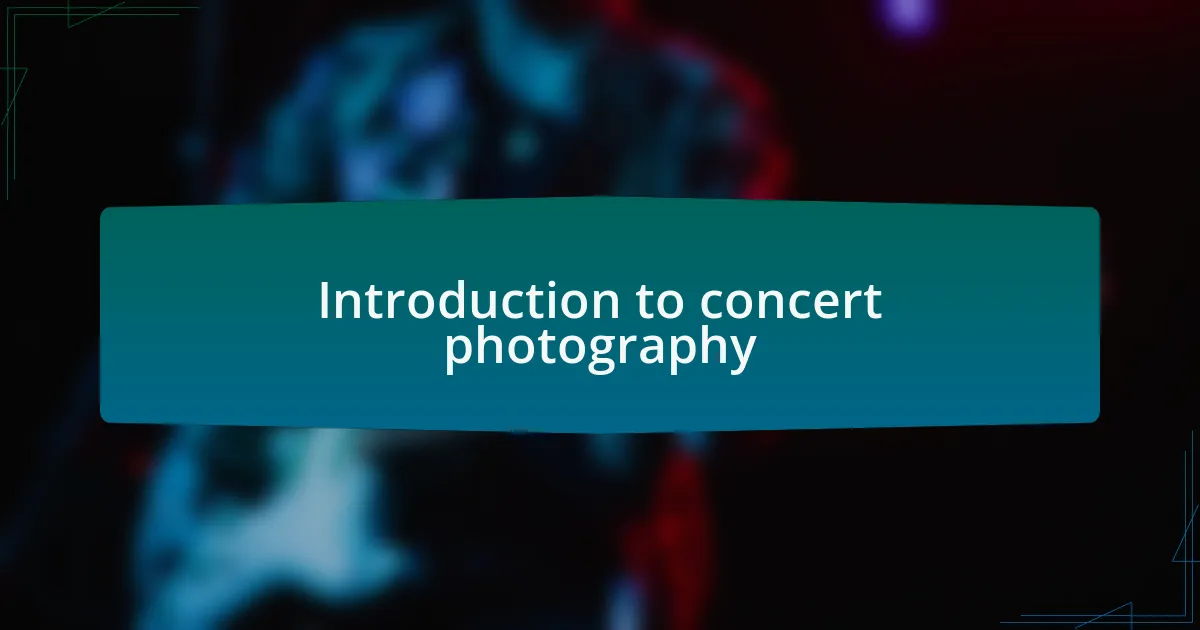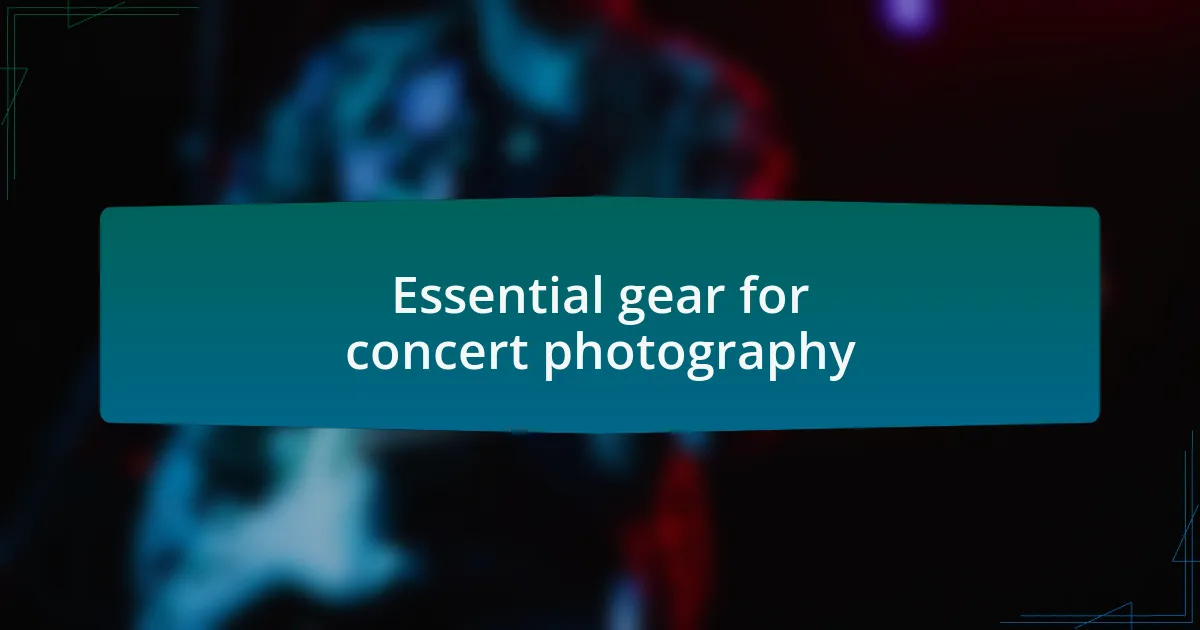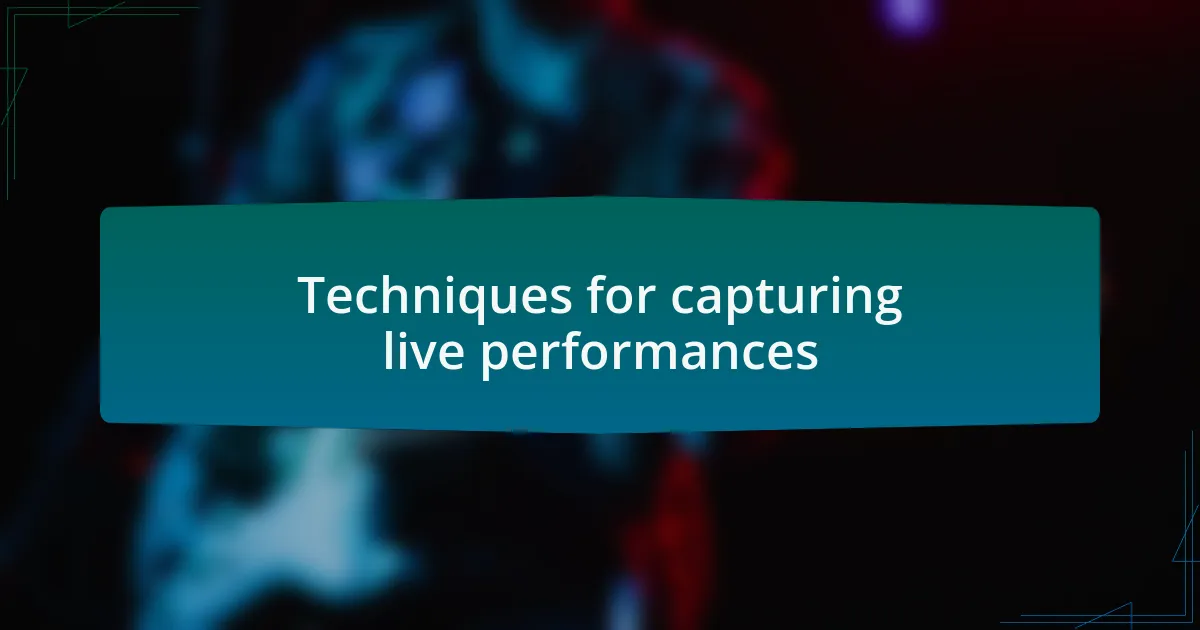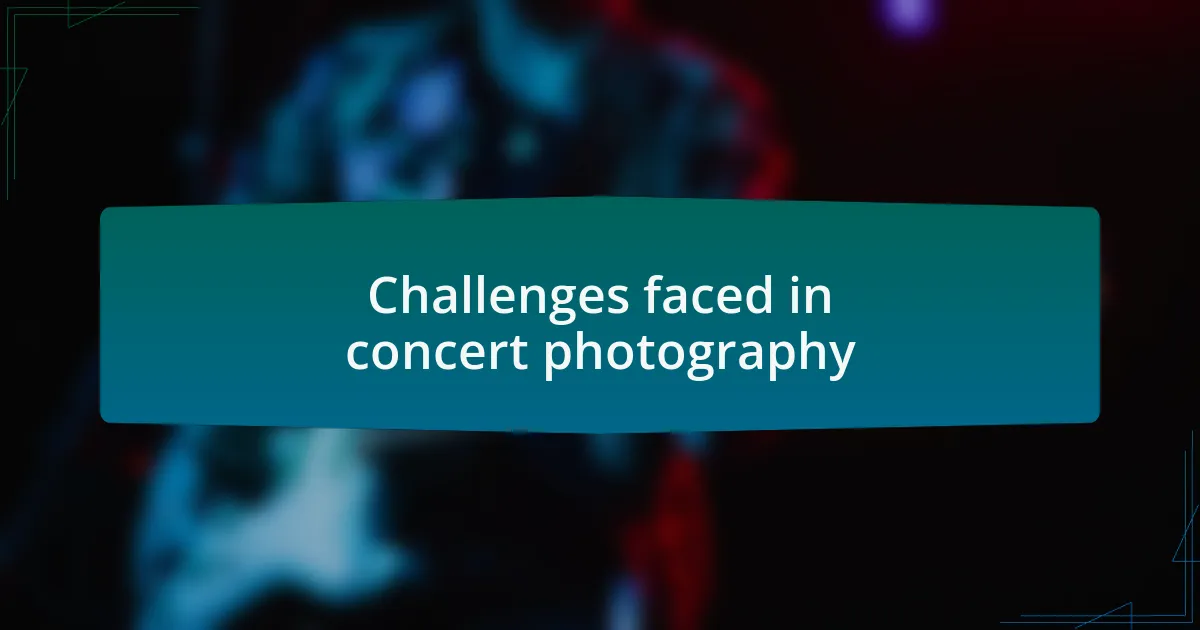Key takeaways:
- Concert photography captures the vibrant energy and emotions of live performances, requiring a keen ability to translate dynamic moments into still images.
- Essential gear includes a fast lens with a wide aperture, a capable camera body for high ISO settings, and a comfortable camera strap to enhance shooting experience.
- Techniques such as anticipating key moments, experimenting with different angles, and adjusting exposure settings are critical for capturing compelling shots.
- Challenges like unpredictable lighting conditions, proximity to performers, and spontaneous artist actions require photographers to adapt quickly and remain instinctively in tune with the performance.

Introduction to concert photography
Concert photography is a unique art form that captures the energy and emotion of live performances. From the moment the lights dim and the crowd roars, there’s an electric atmosphere that I find exhilarating. Have you ever felt that rush as the first notes hit the air? For me, it’s a reminder of why I cherish this craft.
The challenge lies not just in the fast-paced environment, but in translating that vibrant energy into still images. I remember my first concert shoot, where I was trying to juggle settings on my camera while absorbing the moment unfolding before me. Each click of the shutter felt like a heartbeat, capturing fleeting expressions and dynamic movements that tell a story. Isn’t it fascinating how a single photograph can evoke the thrill of being there?
Lighting often varies dramatically, and understanding how to use it is crucial. I often find myself in low-light situations, grappling with settings to bring out the best in each scene. It’s a delicate dance between exposure and emotion, where every adjustment can dramatically change the outcome. Have you ever tried to capture a shadowy figure on stage? The results can be disappointing, yet it’s this challenge that keeps me returning to the lens, eager to improve and discover new perspectives.

Essential gear for concert photography
When it comes to essential gear for concert photography, a fast lens is non-negotiable. I’ve often found myself in the middle of dimly lit venues where every second counts. My go-to is a prime lens with a wide aperture, like f/1.8 or even f/1.4, which allows me to capture bright, sharp images even when the lighting is less than ideal. Have you ever missed a great shot because your lens couldn’t keep up? Trust me; the right lens can be the difference between a blurry disappointment and a stunning moment frozen in time.
Equally important is a sturdy camera body that performs well in high ISO settings. Early in my journey as a concert photographer, I struggled with grainy images, which only reminded me of my equipment’s limitations. Since then, I’ve upgraded to a camera that handles higher ISOs gracefully, allowing me to shoot with confidence even in tricky lighting. I remember one show where the band was drenched in vibrant colors but the light was low. With my improved gear, I was able to capture not just the band, but the entire atmosphere—every color and shadow on full display.
A good camera strap may seem trivial, but it’s a game-changer during long sets. I recall my first few shoots, balancing the weight of my camera and missing pivotal moments because I was preoccupied with discomfort. Investing in an ergonomic strap allows me to focus entirely on the performance, freeing me to move and shoot without distraction. It’s this small yet significant piece of gear that enhances my experience as a photographer, enabling me to immerse myself fully in the action. Isn’t it amazing how little adjustments in gear can lead to a world of difference in your photography journey?

Techniques for capturing live performances
When I’m at a concert, one of my go-to techniques is anticipating the moment. I’ve learned to watch the band closely and pick up on cues when they’re about to make the big gestures—like a lead singer leaning into the crowd or a drummer hitting that powerful crescendo. It’s like a dance; by tuning in to the rhythm of the performance, I can be ready to press the shutter just as the magic unfolds. Have you ever captured a moment that felt electric? That’s how it feels when you’re in sync with the musicians.
Another technique I frequently employ is harnessing the effects of different angles. Shooting from the side of the stage can create dynamic compositions and highlight the musician’s connection with the audience. I remember a particular show where the lighting hit just right, and I managed to get a shot of the guitarist framed by the venue’s graffiti backdrop. It was an unexpected perspective, and it transformed an ordinary moment into something captivating. What have you found works best for your creative angles?
Lastly, don’t underestimate the magic that happens at the right moment of exposure. Balancing shutter speed, aperture, and ISO is essential, but I often experiment with slower shutter speeds to capture the movement of the performers. The swirling lights and dynamic motions can transform a simple shot into a stunning piece of art. I still vividly recall a time when I let the light trails of a dynamic light show blur through the image, giving it a feeling of urgency and life. Have you ever tried pushing the limits of your settings in that way? It might surprise you just how exhilarating the results can be.

Challenges faced in concert photography
When diving into the world of concert photography, one of the toughest challenges I face is the unpredictable lighting conditions. It’s almost a guarantee that each venue will throw something different my way, from dimly lit stages to harsh spotlights that can wash out details. I recall one particularly intense gig where the stage lights fluctuated erratically, and I found myself constantly adjusting settings just to keep up. It was exhausting yet exhilarating—how do you manage your camera settings when the light is constantly shifting?
Another hurdle can be the proximity to the performers and the crowd dynamics. I’ve found myself wedged in tight spaces, desperately trying to navigate the balance between capturing the musician’s energy and the audience’s reactions. At one concert, I was so close to the front that I could feel the excitement of the fans, but that also meant dodging arms and heads while trying to frame my shots. It left me wondering—how do you effectively capture that thrilling connection without losing your own sense of space?
Then, there’s the challenge of the artist’s performance itself. Musicians can be spontaneous, leading to moments that are fleeting and unpredictable. I remember attending a high-energy show where the lead singer leaped into the crowd, and I had a split second to decide whether to follow the action or stay focused on the main stage. In that moment, I realized it’s not just about technical skills but also about being instinctively in tune with the performance—can you trust yourself to capture those raw, fleeting instances? Each of these challenges shapes my journey in concert photography, pushing me to grow each time I’m behind the lens.